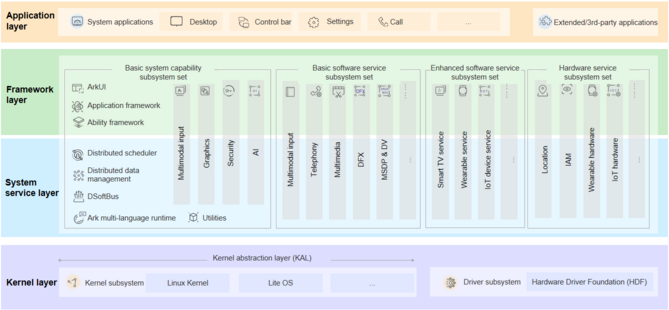HarmonyOS Development Fundamentals: Difference between revisions
Jump to navigation
Jump to search
(add an example - xcompenent) |
mNo edit summary |
||
| Line 17: | Line 17: | ||
* [https://developer.huawei.com/consumer/en/doc/harmonyos-guides/arkui-overview ArkUI]: ArkUI provides a comprehensive infrastructure for UI development of applications, including simple UI syntax, a diverse array of UI features (components, layouts, animations, and interaction events), and a powerful previewer. See also "[https://developer.huawei.com/consumer/en/doc/harmonyos-guides/window-manager Window Manager]" and "[https://developer.huawei.com/consumer/en/doc/harmonyos-guides/display-manager Display Management]". | * [https://developer.huawei.com/consumer/en/doc/harmonyos-guides/arkui-overview ArkUI]: ArkUI provides a comprehensive infrastructure for UI development of applications, including simple UI syntax, a diverse array of UI features (components, layouts, animations, and interaction events), and a powerful previewer. See also "[https://developer.huawei.com/consumer/en/doc/harmonyos-guides/window-manager Window Manager]" and "[https://developer.huawei.com/consumer/en/doc/harmonyos-guides/display-manager Display Management]". | ||
* Other than testing on real HarmonyOS devices, there are Emulators in DevEco Studio, but with some limitations. | * Other than testing on real HarmonyOS devices, there are Emulators in DevEco Studio, but with some limitations. | ||
== Examples == | |||
* Native XComponent: [https://developer.huawei.com/consumer/en/codelabsPortal/carddetails/tutorials_NEXT-XComponent doc(English)], [https://developer.huawei.com/consumer/cn/codelabsPortal/carddetails/tutorials_NEXT-XComponent doc(Chinese)], [https://alliance-communityfile-drcn.dbankcdn.com/FileServer/getFile/cmtyManage/011/111/111/0000000000011111111.20250615155955.47678143795445929234146565896950:50001231000000:2800:E433DA075914535D0847DD4DEDFA75666960948E180EC0158A1D25A7EDED5629.zip?needInitFileName=true XComponent.zip], [https://gitee.com/harmonyos_codelabs/XComponent code-repo(gitee)], [https://gitcode.com/HarmonyOS_Codelabs/XComponent code-repo(gitcode)] | * Native XComponent: [https://developer.huawei.com/consumer/en/codelabsPortal/carddetails/tutorials_NEXT-XComponent doc(English)], [https://developer.huawei.com/consumer/cn/codelabsPortal/carddetails/tutorials_NEXT-XComponent doc(Chinese)], [https://alliance-communityfile-drcn.dbankcdn.com/FileServer/getFile/cmtyManage/011/111/111/0000000000011111111.20250615155955.47678143795445929234146565896950:50001231000000:2800:E433DA075914535D0847DD4DEDFA75666960948E180EC0158A1D25A7EDED5629.zip?needInitFileName=true XComponent.zip], [https://gitee.com/harmonyos_codelabs/XComponent code-repo(gitee)], [https://gitcode.com/HarmonyOS_Codelabs/XComponent code-repo(gitcode)] | ||
Revision as of 07:25, 8 October 2025
This page is still under development.
HarmonyOS and OpenHarmony
HarmonyOS is developed by Huawei for smartphones, tablets, smart TVs, smart watches, personal computers and other smart devices. OpenHarmony is a family of open-source distributed operating systems based on HarmonyOS derived from LiteOS, donated the L0-L2 branch source code by Huawei to the OpenAtom Foundation.
Technical Architecture
Technical Details
- IDE: DevEco Studio which runs on Windows and macOS(Intel+Apple silicon), see also "Environment Setup - Overview".
- Command Line Tools which runs on Windows, macOS(Intel+Apple silicon) and Linux
- HUAWEI Developer ID, more details in this page
- Node-API: Developed based on the Node.js 12.x LTS Node-API, HarmonyOS Node-API allows interaction between ArkTS/JS and C/C++ modules. It provides a set of stable APIs that can be used on different operating systems. See also "Node-API Overview" and "Node-API Development Process".
- ArkTS: ArkTS is the official high-level language for HarmonyOS application development. See also "ArkTS Cross-Language Interaction".
- ArkUI: ArkUI provides a comprehensive infrastructure for UI development of applications, including simple UI syntax, a diverse array of UI features (components, layouts, animations, and interaction events), and a powerful previewer. See also "Window Manager" and "Display Management".
- Other than testing on real HarmonyOS devices, there are Emulators in DevEco Studio, but with some limitations.
Examples
- Native XComponent: doc(English), doc(Chinese), XComponent.zip, code-repo(gitee), code-repo(gitcode)
